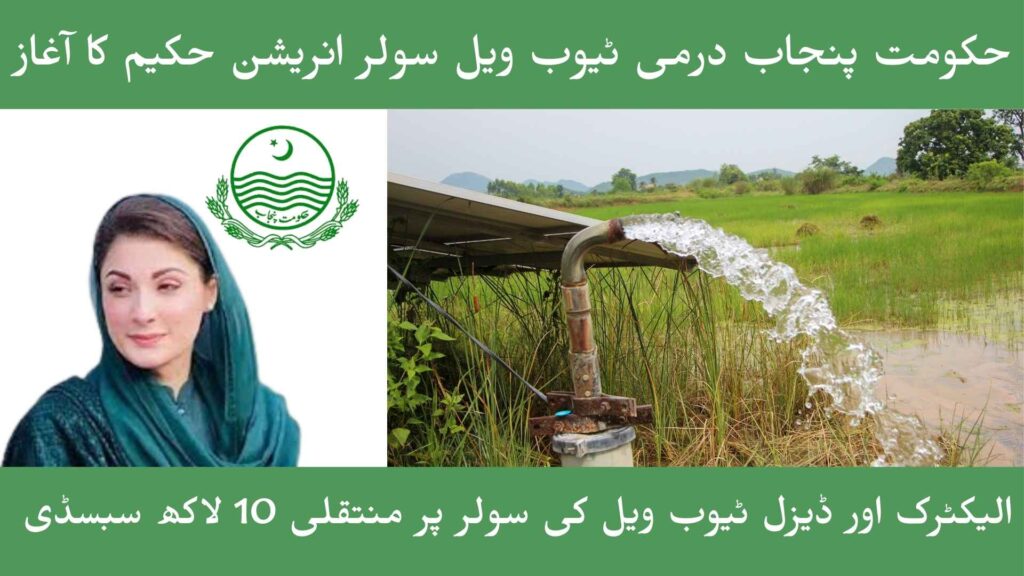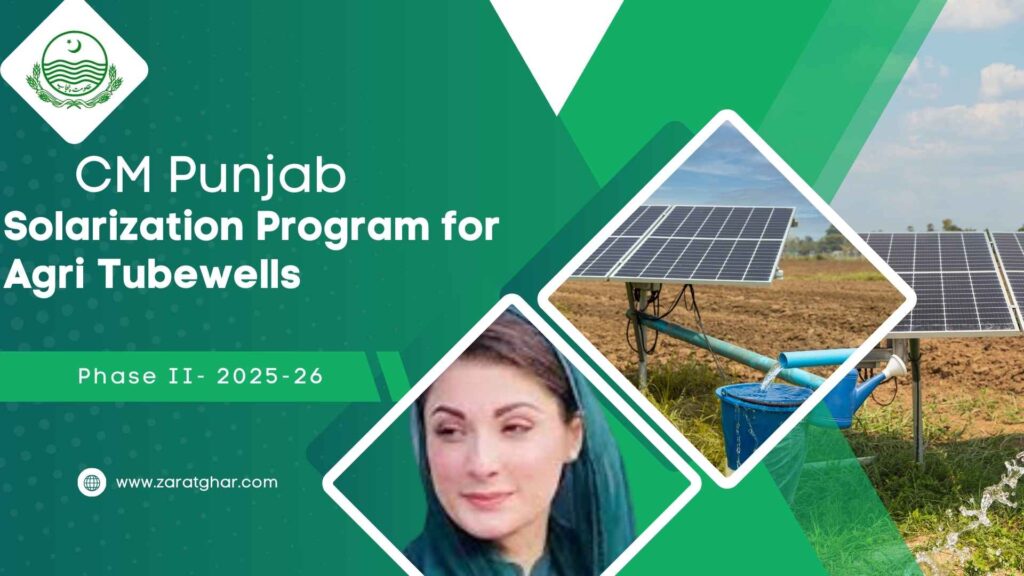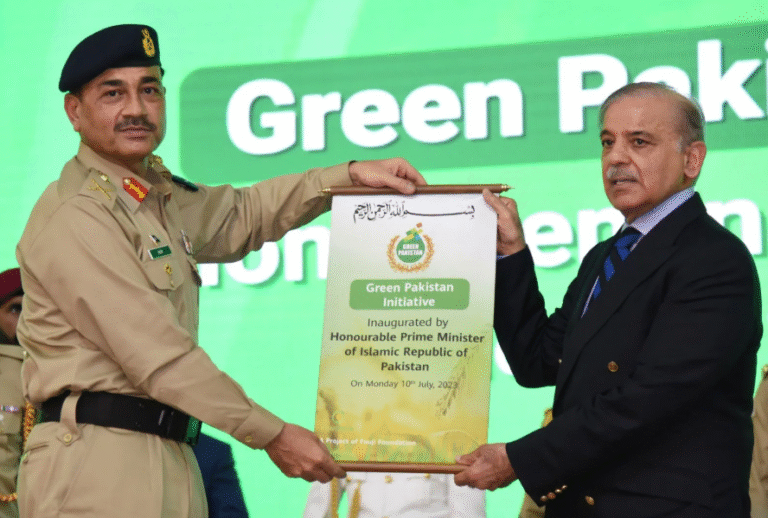CM Solarization Program for Agri Tubewells
The CM Solarization Program for Agri Tubewells aims to shift irrigation away from costly grid and diesel power.
The provincial government has allocated Rs. 9,887.42 million over 2024-25 and 2025-26. This fund will solarize 7,000 tubewells with full kits: panels, inverters, batteries, and balance-of-system.

Farmers pay a 25% upfront share. The remaining 75% is covered by a subsidy and paid via interest-free installments through the Bank of Punjab.
The initiative runs under the chief minister’s oversight and uses district-level balloting for fair access. Eligible applicants must be Punjab residents with CNIC, Fard-e-Malakiat, and FRC, own an electric tubewell up to 15 kW with a three-phase connection, have a water table within 60 feet, and not be defaulters.
This introduction previews practical benefits: steadier irrigation costs, fewer interruptions, and stronger farm resilience under a clean-energy plan.
Key Takeaways
- The scheme finances 7,000 tubewells with Rs. 9,887.42 million over two years.
- Farmers pay 25% upfront; 75% is subsidy-backed with interest-free repayment.
- Eligibility needs Punjab residency, land documents, a three-phase tubewell up to 15 kW, and non-defaulter status.
- District-level lottery ensures transparent and fair distribution.
- Expected benefits include reliable irrigation energy and lower long-term costs.
Breaking: Punjab launches solarization drive for agricultural tube wells
Punjab has unveiled a major drive to retrofit thousands of agricultural tube wells with solar systems. The rollout targets 7,000 units on a cost-share basis and uses a district-level lottery to ensure fair allocation.
Application forms are now available at Deputy Director Agriculture (Water Management) offices. District balloting dates and quotas are being published across print media and local offices to reach remote areas.

Banking channels, led by the Bank of Punjab, are prepared to register applicants and process interest-free installment plans. Farmers should gather CNIC and land documents early to speed verification and avoid queue delays.
Market context: the launch arrives amid upbeat sentiment—maryam nawaz is overseeing rollout messaging while headlines note rupee gains ground, usd pkr interbank moves, and reports that karachi inches closer to index milestones. Activity by textile mills limited also reflects wider sector momentum.
- Next steps: expect detailed guidance on eligibility, subsidy levels, and online tracking of applications.
What the CM Punjab Solar Scheme for Tubewell means for farmers today
Converting electric tube wells to solar supply changes how farmers plan irrigation and seasonal cash flow. This shift targets electric pumps up to 15 kW with three-phase connections and wells no deeper than 60 feet.
Practical gains: daytime pumping becomes more reliable, cutting dependence on costly grid power and backup diesel. Lower running costs free cash that a farmer can use for seed, fertilizer, and pest control.
Eligibility is clear: applicants must be Punjab residents with CNIC, Fard-e-Malakiat, and FRC, hold an active connection by March 31, 2024, and not be bill defaulters. These rules help farmers self-check before applying.
“Fair balloting and capped down payments open access to smallholders across districts.”
- More predictable water windows align irrigation with peak sunlight.
- District lotteries aim to include remote and small-scale holders.
- Interest-free instalments help manage seasonal income swings.
| Benefit | Immediate effect | Long-term gain |
|---|---|---|
| Reliability | Daytime pumping without outages | Stable crop schedules |
| Cost | 25% capped down payment | Lower input budgeting pressure |
| Access | District-level balloting | Equitable reach for smallholders |
Program at a glance: scope, budget, and timeline
Punjab has set aside Rs. 9,887.42 million to fund full solar pump packages and related services. The plan runs across two years, with Rs. 2,500 million earmarked for 2024-25 to kick-start procurement and installations.
Allocation and gestation period: Rs. 9,887.42m over 2024-26
The budget covers panels, inverters, batteries, balance-of-system and the project management needed to deliver reliable installations. The staged approach aligns procurement cycles with field teams to keep quality checks tight.
Target and coverage: 7,000 tubewells across Punjab
The target of 7,000 installations balances scale with verification and district quotas. Standardized cost-sharing and a clear subsidy split make farmer contributions transparent and predictable.
- The govt allocation funds hardware, screening, balloting, and after-sales oversight.
- Phased timelines help farmers plan cropping and irrigation windows as systems come online.
- Overall aims include better water productivity, climate resilience, and improved financial returns at farm level.
“A defined budget and timeline give farmers clarity and help delivery teams meet annual targets.”
Leadership and governance: Chief Minister Maryam Nawaz Sharif’s pledge in action
Maryam Nawaz Sharif moved quickly to convert an election promise into a working plan that targets irrigation energy costs. The chief minister announced institutional ownership and fast-track delivery soon after taking office.
The initiative is framed as relief for farmers and a modernization step for rural energy security. District-level balloting and clear quota rules aim to make selection fair and visible to the public.
The provincial government has set the Agriculture Department’s Water Management Wing to run technical screening and field checks. This office manages eligibility, documentation audits, and non-defaulter verification to reduce misuse.
Nawaz Sharif’s broader development narrative gives the rollout political momentum. Farmers gain accessible accountability channels, with district offices helping applicants and handling follow-up queries.
“Transparent balloting and strict verification help ensure aid reaches real farm operators.”
- Clear ownership: chief minister’s office set policy and oversight.
- Transparency: district lotteries and published screening standards.
- Fair access: quotas and checks prevent multiple allocations within families.
Key features shaping on-farm energy and water use
A low entry cost and clear repayment plan make shifting pumps to solar financially accessible. This section outlines the features that matter most to farmers and local water management.
Minimal upfront cost with five-year repayment
Farmers pay 25% upfront. The balance is financed interest-free over five years with provincial subsidy support.
Transparent lottery for fair distribution
Fair balloting spreads allocations across districts. This reduces concentration among larger holders and helps small-scale operators access benefits.
Complete solar package: panels, inverters, batteries, and balance of system
Full kits ensure all parts match and work together. Batteries smooth short cloud cover and keep pumps running during key irrigation hours.
Operational and environmental gains from solar-powered tube wells
Operational gains include lower running costs, fewer outages, and protection against fuel price spikes. Water delivery becomes more predictable, helping farmers target efficient irrigation windows.
- Lower cash barriers with a five-year plan.
- Equitable access via district lottery.
- Reliable hardware in one integrated system.
- Reduced emissions and quieter, cleaner operation.
“Consistent daytime pumping lets farmers time irrigation to light and save on inputs.”
Subsidy structure and system sizes available
Subsidy tiers and system choices give farmers a clear path to match capacity with pump demand and water needs. The scheme offers fixed grants at three capacity points so buyers and installers can plan costs and installation area accurately.
10 kW
PKR 500,000 subsidy. This size suits many tube wells with moderate daily demand and smaller panel footprints.
15 kW
PKR 750,000 subsidy. Ideal for wells near the technical cap and most three-phase pump setups used by farmers.
20 kW
PKR 1,000,000 subsidy. Available where higher load is allowed and where wells serve larger irrigation plots.
How cost sharing works: Farmers still cover the remaining system cost on top of the 25% down payment and benefit from interest-free installments. Clear subsidy numbers reduce uncertainty and help plan seasonal cash flows.
“Transparent subsidy tiers simplify budgeting and encourage wider uptake among small and medium holders.”
- Three sizes let farmers balance irrigation needs, panel area, and expected yield from sunlight.
- Standardized subsidies reduce procurement variation and simplify maintenance planning.
- Knowing PKR amounts upfront helps align payments with cropping cycles.
| System size | Subsidy (PKR) | Best fit |
|---|---|---|
| 10 kW | 500,000 | Small to medium wells; limited panel space |
| 15 kW | 750,000 | Most three-phase wells up to technical cap |
| 20 kW | 1,000,000 | Higher demand sites where permitted |
Eligibility criteria farmers must meet
Eligibility hinges on clear identity and land documents plus technical checks on the pump and well.
Residency and ownership documents
Applicants must be Punjab residents and present CNIC, Fard-e-Malakiat, and FRC at submission. These papers verify identity and legal land ownership.
Technical requirements
Only electric tube pumps up to 15 kW with a three-phase connection qualify. The setup ensures inverter and motor compatibility and safe operation.
Hydrogeological checks are mandatory. Wells with a water table deeper than 60 feet are not eligible to keep pumping performance reliable.
Connection date and payment discipline
The electricity connection must have been active by March 31, 2024. Applicants who are bill defaulters will be disqualified.
“The government’s screening is designed to be consistent across districts to avoid ambiguity.”
- Prepare CNIC, Fard-e-Malakiat and FRC early to speed verification.
- Confirm three-phase wiring and pump kW rating before applying.
- Non-defaulter status and a valid connection date are essential to pass scrutiny.
How to apply: official channels and verification
Collect the official form at the local Water Management office and keep an eye on newspaper bulletins for deadlines and ballot schedules. Deputy Director Agriculture (Water Management) offices are the only authorized pickup and submission points.
Application and notices
Print media announcements will list cutoffs, required documents, and when district quota balloting will take place. Applicants should note published dates and attend any public briefings.
Verification and fair selection
Submitted forms undergo checks on identity, land ownership, tubewell technical compliance, and bill status. The govt uses standardized scrutiny to keep approvals consistent and quick.
“Retain copies of forms and receipts; they help track your file and support appeals if needed.”
- Farmers must submit CNIC and land papers at the office.
- District quota balloting distributes installations equitably across areas.
- Timely filing improves chances to enter earlier ballot cycles.
Bank of Punjab onboarding and farmer payments
Bank branches are the on-ramp where registration, financing and subsidy tracking come together.
Registration begins at the nearest Bank of Punjab office. Staff verify CNIC and land documents and link each file to the approved application.
Branch registration and 25% down payment to secure ownership
Farmers deposit a 25% down payment at the branch to confirm ownership of the solar system. This step is required before installers schedule field work.
Interest-free installment facilitation aligned with provincial subsidy
The bank coordinates the provincial subsidy and spreads the remaining balance into interest-free installments. This structure keeps monthly obligations aligned with typical crop income cycles.
- Branch registration links documents to financing and vendor payments.
- Down payment secures scheduling and warranty activation.
- Interest-free terms lower upfront cost and support steady investment in farm productivity.
- Farmers should keep receipts and confirm service and savings estimates during their banking visit.
“Keep proof of payments and agreements; they ease warranty claims and service follow-ups.”
CM Solarization Program for Agri Tubewells
A single, integrated package lets farmers switch pump energy sources and plan water use with more certainty.
What it delivers: full kits that include panels, inverters, batteries and balance-of-system components. The offer is tied to district quota balloting to keep allocation fair and visible.
The scheme backs high-efficiency irrigation and encourages planting higher-value crops by making daytime pumping reliable. Reduced monthly energy costs help farmers budget better across seasons.
Fair access matters: transparent balloting and clear documentation checks aim to include smallholders and reduce concentration among large landowners.
Practical steps are simple: follow official channels at district Water Management and Bank of Punjab outlets for application, verification, and payment milestones. Ongoing notices will announce upcoming balloting dates and installation windows.
“Steady, predictable irrigation lets growers time water to sunlight and protect yields.”
- Full system packages speed installation and lower setup risk.
- Quota-based balloting promotes broad participation.
- Lower energy bills and predictable schedules strengthen on-farm resilience under maryam nawaz leadership.
Cost-sharing explained: from list price to farmer outlay
Start with the list price of a full kit, subtract the fixed provincial subsidy, then apply the 25% down payment. The remainder is split into interest-free installments over five years to keep monthly cash needs low.
Worked examples: estimating farmer contribution under each kW tier
10 kW example: assume a list price of PKR 1,200,000. Subtract the PKR 500,000 subsidy to get PKR 700,000 net. A 25% down payment equals PKR 300,000, leaving PKR 400,000 to be paid over five years.
15 kW example: using PKR 1,600,000 list price less PKR 750,000 subsidy gives PKR 850,000 net. The 25% down payment is PKR 400,000; balance is PKR 450,000 amortized over years.
20 kW example: with a PKR 2,200,000 list price minus PKR 1,000,000 subsidy the net is PKR 1,200,000. A 25% down payment of PKR 550,000 leaves PKR 650,000 for five-year installments.
| System size | Typical list price (PKR) | Subsidy (PKR) | Down payment (25%) | Balance over 5 years |
|---|---|---|---|---|
| 10 kW | 1,200,000 | 500,000 | 300,000 | 400,000 |
| 15 kW | 1,600,000 | 750,000 | 400,000 | 450,000 |
| 20 kW | 2,200,000 | 1,000,000 | 550,000 | 650,000 |
Notes: final figures vary with component choices and site conditions. Compare expected monthly instalments to current tube pump running costs to judge payback speed.
“Interest-free years and a fixed subsidy make the farmer’s monthly exposure much lower than market loans.”
- Prepare CNIC, land documents and bank receipts before branch registration.
- Confirm pump kW rating and well depth to match eligibility rules.
- Ask the Bank of Punjab to show an amortization schedule before paying the down amount.
Who benefits first: prioritizing small-scale cultivators
Early rounds favor modest landowners to ensure more households benefit quickly. The design gives priority to small-scale cultivators through district quotas and a clear one-system-per-family rule.
District balloting aims to spread hardware across regions rather than concentrate it. Verification checks confirm land ownership and an active tubewell connection before approval.
- One system per family widens participation and limits multiple awards to the same household.
- District quotas manage geographic distribution so remote areas receive allocation.
- Verification requires CNIC, Fard-e-Malakiat and proof of an active connection to reduce misuse.
- Policy focus by the punjab government and maryam nawaz frames early access as support for vulnerable incomes.
| Priority feature | Why it matters | Expected outcome |
|---|---|---|
| Smallholder preference | Targets tight-margin farms | Better household cash flow |
| One per family rule | Limits concentration | Wider community reach |
| District quotas | Balances urban and rural access | Geographic equity |
| Document verification | Confirms real operators | Reduces fraud, speeds delivery |
“Prioritizing small farms helps stabilise incomes and extends benefits across more families.”
Practical tip: farmers should prepare clear proof of holding size, CNIC, Fard-e-Malakiat and connection receipts when they apply. Accurate documentation speeds verification and improves the chance of early selection.
Impact on yields, water efficiency, and input costs
Reliable daytime pumping lets growers schedule water to match crop critical stages. This improves fruit set and crop quality for vegetables, orchards, and other high-value plantings.
High-efficiency irrigation and high-value crops focus
High-efficiency irrigation reduces losses and keeps moisture where roots need it. That improves nutrient uptake and boosts yield stability.
Farmers can time irrigation to daylight, protecting sensitive crops from stress during flowering and early fruiting. Better scheduling raises market grades and helps fetch higher returns.
Reducing exposure to rising commercial electricity prices
Switching pump energy to on-site solar cuts reliance on costly grid supply. That lowers monthly operating costs and reduces exposure to sudden price hikes.
- Timely irrigation sustains yields of value crops sensitive to water stress.
- Efficient setups limit losses and improve moisture control.
- Savings on energy let farmers reinvest in seed, fertigation, and crop protection.
| Impact area | Practical effect | Benefit to farmers |
|---|---|---|
| Yield & quality | Better timing of irrigation at critical stages | Higher market grades and income |
| Water use | Reduced losses with targeted delivery | More crop per drop |
| Costs | Lower electricity bills and less generator use | Funds for inputs and expansion |
| Data & upgrades | Performance tracking informs drip or automation | Efficient long-term investments |
“Stable water availability improves crop scheduling and protects yields.”
Oversight and transparency: ensuring equitable access
Published screening standards and open lottery records reduce discretion and speed fair approvals. The Agriculture Department’s Water Management Wing runs verification and checks key documents such as CNIC, Fard-e-Malakiat and FRC to confirm ownership and eligibility.
District quota balloting is documented and auditable. This makes allocation traceable and helps the government answer public queries quickly.
- Consistent verification: transparent standards guide checks so similar cases get similar outcomes.
- Auditable ballots: district records and published lists make the process visible to the public.
- Strong documentation: CNIC, FRC and land papers deter misuse and keep benefits with genuine farmers.
- Grievance channels: clear appeal routes let applicants challenge or clarify decisions.
- Staff training: district teams receive guidance to apply rules uniformly and to notify applicants on time.
The wider enforcement climate supports rule-based allocation. Instances where court jails illegal actors or cases against illegal currency dealers make public expectations clear. References to jails illegal currency highlight the government stance on compliance.
“Registered taxpayers adopting formal channels often find smoother access and faster approval.”
Today’s market context and banking linkages
Market activity is reflecting faster onboarding as banks and investors watch registration flows tied to large-scale installations. Equity moves and currency shifts shape import costs and the near-term logistics of procurement.
Bank of Punjab stock edges higher as registrations proceed (Aug 12, 2025)
Bank of Punjab closed at 14.34, up 1.85% on Aug 12, 2025. Headline indices were firmer: KSE100 rose 0.54% and KSE30 gained 0.35%.
Selected movers included DGKC and NBP higher, while PPL and PRL eased. This breadth gives a constructive backdrop as branch teams register applicants and process instalments.
- Currency note: rupee gains ground against the dollar, and usd pkr interbank swings affect component price and supply timing.
- Industrial names such as spinning mills limited and textile mills limited tracked activity that ties to rural demand and logistics.
- Bank readiness covers branch processing, debit credit card acceptance and credit card machines for fees where needed.
| Indicator | Value (Aug 12) | Relevance |
|---|---|---|
| BOP share | 14.34 (+1.85%) | Signals investor attention to transaction flows |
| KSE100 | 147,730 (+0.54%) | Healthy market backdrop for public initiatives |
| Currency | Rupee gains ground | Lowers import price pressure on components |
“Branch-level systems and clear operational codes must be in place to keep sign-ups smooth.”
What’s next: registration window and awareness campaign
Local print campaigns and bank counters will be the frontline of the next registration phase. Notices in newspapers will list district timelines and ballot dates.
Where to register: forms are available at Bank of Punjab branches and Deputy Director Agriculture (Water Management) offices. Farmers must bring CNIC and land documents and be ready to pay the 25% down payment to secure their system.
On-site support will include clear signage and staffed desks to explain steps before balloting. This reduces queuing and speeds verification.
- Payment counters at branches will accept common methods, including debit credit card use.
- Standardized credit card machines and verified card machines codes will ease peak-period flows.
- Operational checks ensure machines codes must match bank lists and codes must integrated across terminals to limit errors.
“Early registration helps align installations with cropping calendars and avoids late-season delays.”
The punjab government urges prompt sign-up and advises farmers to monitor official channels for district-specific cutoffs and notices.
Conclusion
By pairing subsidy support with interest-free bank finance, maryam nawaz sharif and the chief minister’s office have turned a large upfront investment into manageable outlays for farmers over the coming years.
Clear eligibility rules and district balloting protect program integrity and widen access to agricultural tube wells. This structure helps smallholders and larger farms adapt to a severe water crisis while smoothing seasonal cash flow.
The rollout sits against wider debates — from njhp tunnel collapse and tunnel collapse costs to nespak rules updated and fiscal topics like banking income taxable. Strong enforcement (court jails illegal) and sector signals such as textile mills limited and aug yousaf weaving shape the policy climate.
In short, transparent governance and bank-backed finance can reduce risk, boost yield stability, and make resilient irrigation a practical investment for farmers.
See Also;
- Pakistan’s Digital Loan Scheme for Farmers
- Agricultural Farm Mechanization Project
- CM Punjab Kissan Card
- CM Punjab Wheat Support Program 2025






